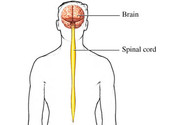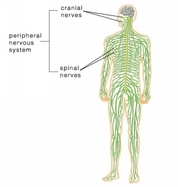Basic Inormation & Functions
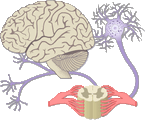
The nervous system is the body's communication system. It has a complex job and is a complex system that matches the task it is endowed with. To begin, the two trademark components of the nervous system are the spinal cord and the brain. They are what make up the Central Nervous System (CNS). Messages are conveyed from all over the body to the spinal cord and then to the brain via neurons. The brain is actually just a condensed bundle of billions of neurons. The network of neurons all over your body is called the peripheral nervous system (PNS). All of the time, the brain sends concious and unconcious mesages to all of the systems throughout the body via the spinal cord and nerves. The brain is also what allows humans their unique abilities to think, plan, speak and feel emotions and the not so unique ability to respond to stimuli. When a source (internal or external) excites a neuron it sends an electrical pulse to the brain . The brain interprets this signal and orders a response which is also sent throught he nervous system. It is through this process that the nervous system controls all of the senses, conscious movements, unconcious movements, regulation of certain things and release of horomones.
Breaking it down: Level 1: Some Important Parts of the Brain
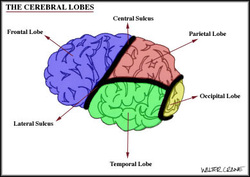
The cerebal cortex controls all thought, voluntary movement, language, reasoning and perceptions. The cerebral cortex is the upper division and is covered in complex grooves. It is the part of the brain and what makes humans so special and different from other animals. Lower animals have fewer grooves in their brains. The cerebral cortex is divided into four lobes (frontal, temporal, occipital and parietal all with their own specefic functions) and hemispheres (left and right). The two brain hemispheres of the cerebral cortex are connected by the corpus callosum.
Continued...
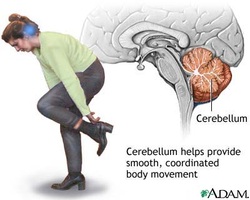
The cerebellum controls a persons movement, posture and balance. It is found behind the brain stem at the base of the cerebral cortex. It is divided into two hemispheres. When damage is done to a person's cerebellum they may rendered unable to walk or coordinate movements.
Continued...
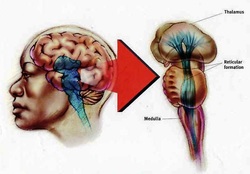
The brain stem controls breathing, heart rate and blood pressure. It is found between the the thalamus and the spinal cord. If damage is done to someone's brainstemt they will most likely pass away. One can live in a vegetative state if another part of their brain is severly damaged but the brain stem remains intact.
Continued...
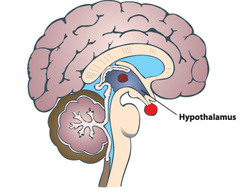
The hypothalamus controls the body's temperature, hunger, thirst, emotions and Circadian rhythm. The Circadian rhythm is your body's own clock. For example, you may wake up at the same time every day. That is thanks to your Circadian rhythm. It is small (only about the size of a pea). Another important function of the hypothalamus is its control of the Pituitary gland.
Continued...
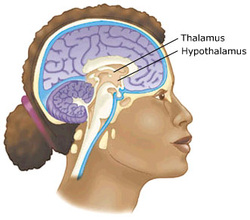
The thalamus is a primitive part of the brain that controls sensory processing and movement. Its function is to relay messages from the spinal cord to the cerebral cortex for processing. The thalamus also helps transmit messages form one part of the brain to another.
and last, but not least....
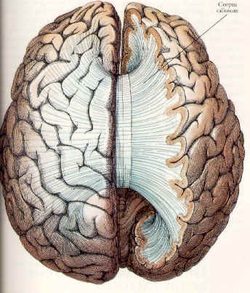
The corpus callosum is a band of fibers that connect the right hemisphere of the brain to the left hemisphere of the brain. The corpus callosum allows messages to travel from one side of the brain to another. Because the two hemispheres interpret information differently, if your corpus callosum is severed, you will never be able to process information again in the same way. The corpus callosum is sometimes severed surgically for people who suffer from seizure disorders. By cutting the corpus callosum it prevents haywire electrical impulses from spreading throughout the brain and causing a seizure. It is an extreme procedure but worth it for some people suffering from sever seizures that occur too often to allow for the normal living of life.
Breaking it down: Level 2: CNS v. PNS
Breaking it down: Level 3: Basic Neurons
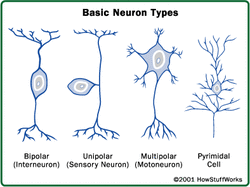
Sensory neurons detect sensory information triggered by exterior stimuli. They fire an electrochemical message.
Interneurons bridge the gap between sensory neurons and the spinal cord. They carry the messages given off by sensory neurons to the spinal cord which carries it to the brain.
The brain decides of a response and initiates a signal. The signal travels own the spinal cord and tot he motor neurons. The motor neurons trigger a physical response to the stimuli.
All of this is done in a matter of milliseconds.
Exception: Cranial Nerves control motion and feeling in the face. These nerves do not pass through the spinal cord.
Interneurons bridge the gap between sensory neurons and the spinal cord. They carry the messages given off by sensory neurons to the spinal cord which carries it to the brain.
The brain decides of a response and initiates a signal. The signal travels own the spinal cord and tot he motor neurons. The motor neurons trigger a physical response to the stimuli.
All of this is done in a matter of milliseconds.
Exception: Cranial Nerves control motion and feeling in the face. These nerves do not pass through the spinal cord.
Second Helping: Taste
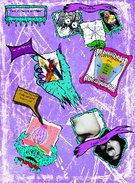
Image Citations:
http://leavingbio.net/THE%20NERVOUS%20SYSTEM_files/THE%20NERVOUS%
http://www.csuchico.edu/~pmccaffrey/syllabi/CMSD%20320/362unit4.html
http://health.allrefer.com/pictures-images/cerebellum-function.html
http://www.rhsmpsychology.com/Handouts/brainstem.htm
http://zaborina.i.ph/photo/108/109
http://163.16.28.248/bio/activelearner/40/ch40c2.html
http://www.umm.edu/imagepages/18008.htm
http://www.carleton.ca/49.663/web.htm
http://www.beliefnet.com/healthandhealing/getcontent.aspx?cid=11663http://sciencecity.oupchina.com.hk/biology/student/glossary/peripheral_nervous_system.asp
http://www.csuchico.edu/~pmccaffrey/syllabi/CMSD%20320/362unit4.html
http://health.allrefer.com/pictures-images/cerebellum-function.html
http://www.rhsmpsychology.com/Handouts/brainstem.htm
http://zaborina.i.ph/photo/108/109
http://163.16.28.248/bio/activelearner/40/ch40c2.html
http://www.umm.edu/imagepages/18008.htm
http://www.carleton.ca/49.663/web.htm
http://www.beliefnet.com/healthandhealing/getcontent.aspx?cid=11663http://sciencecity.oupchina.com.hk/biology/student/glossary/peripheral_nervous_system.asp
